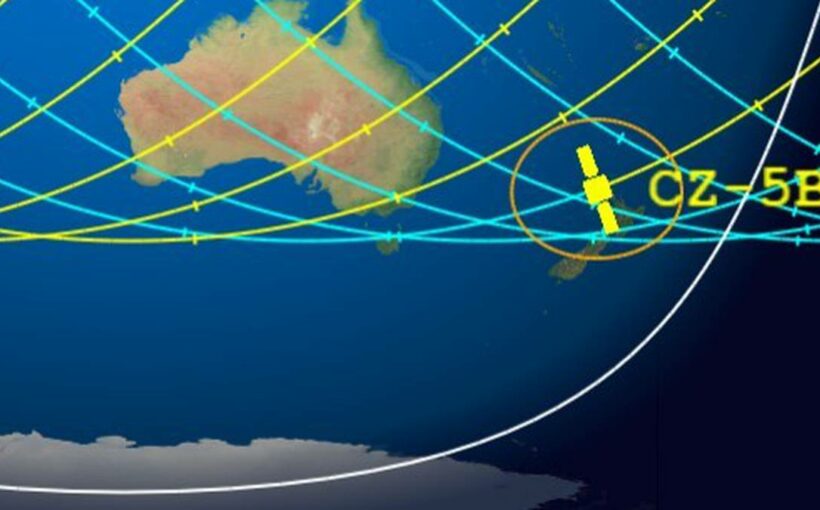Calculations into where a section of an out-of-control rocket will land this weekend have been updated – and New Zealand’s North Island is the latest “informed prediction”.
But don’t panic – China’s foreign ministry saidmost debris from the rocket will be burned up on re-entry and is highly unlikely to cause any harm. Experts added that pinpointing the re-entry location was extremely difficult and debris is likely to land in the ocean.
In a tweet sent on Friday evening in the US, the Aerospace Corporation said the latest prediction for the re-entry of the 18-tonne Long March 5B rocket body by its Centre for Orbital Reentry and Debris Studies (CORDS) was for eight hours either side of 0419 GMT on Sunday (8am-midnight Sunday NZ time).
CORDS’ latest “informed prediction” showed near the North Island as a likely location – but it noted that re-entry was possible anywhere along paths covering large parts of the globe.
Usually first-stage rockets re-enter soon after lift-off, normally over water, and don’t go into orbit like this one did.
An astrophysicist earlier this week revealed New Zealand is one of a number of worldwide locations in the path of the rocket’s trajectory – though it is more likely the debris will fall in the ocean.
Harvard-based astrophysicist Jonathan McDowell said potentially dangerous debris will likely escape incineration but in all likelihood would fall into the sea, given that 70 per cent of the world is covered by ocean.
McDowell, a member of the Harvard-Smithsonian Centre for Astrophysics, said the rocket’s main stage core would likely break into a shower of debris equivalent to that of a small plane crash and come down in a narrow trail stretching about 160km.
Based on its current orbit, the debris trail is likely to fall somewhere as far north as New York, Madrid or Beijing and as far south as southern Chile and Wellington, New Zealand, or anywhere in between, McDowell said earlier this week.
China newspaper the Global Times, published by the Chinese Communist Party, said the stage’s “thin-skinned” aluminum-alloy exterior will easily burn up in the atmosphere, posing an extremely remote risk to people.
The situation is “not worth panicking about,” it said, citing industry insiders.
“Most of the debris will burn up during re-entry … leaving only a very small portion that may fall to the ground, which will potentially land on areas away from human activities or in the ocean,” Wang Yanan, chief editor of Aerospace Knowledge magazine, was quoted as saying by the newspaper.
The US Defence Department earlier this week said the Long March 5B rocket core “cannot be pinpointed until within hours of its re-entry”.
An astronomer at the Paris-PSL Observatory, Florent Delefie said: “Given the size of the object, there will necessarily be big pieces left over.” But added, “the chances of debris landing on an inhabited zone are tiny, probably one in a million.”
White House press secretary Jen Psaki at a Wednesday briefing said the US Space Command was “aware of and tracking the location” of the Chinese rocket.
The Long March 5B rocket carried the main module of Tianhe, or Heavenly Harmony, into orbit on April 29. China plans 10 more launches to carry additional parts of the space station into orbit.
The roughly 30m-long stage would be among the biggest space debris to fall to Earth.
The 18-tonne rocket that fell last May was the heaviest debris to fall uncontrolled since the former Soviet space station Salyut 7 in 1991.
China’s first space station, Tiangong-1, crashed into the Pacific Ocean in 2016 after Beijing confirmed it had lost control. In 2019, the space agency controlled the demolition of its second station, Tiangong-2, in the atmosphere.
In March, debris from a Falcon 9 rocket launched by US aeronautics company SpaceX fell to Earth in Washington and on the Oregon coast.
Source: Read Full Article

/cloudfront-ap-southeast-2.images.arcpublishing.com/nzme/LYY4JTCASDPDXOY5SM3XULPOOI.jpg)
/cloudfront-ap-southeast-2.images.arcpublishing.com/nzme/AHP6CWEZETK45W54JU6OXKWZ5E.jpg)
/cloudfront-ap-southeast-2.images.arcpublishing.com/nzme/EDZ6HDEEQUVRBGGNN7CNCBJ72M.jpg)